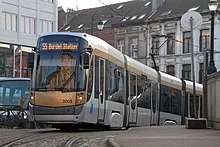Brussels trams

A Bombardier T3000 in Brussels, 2010.
|
|||||||||
| Operation | |||||||||
|---|---|---|---|---|---|---|---|---|---|
| Locale | Brussels, Belgium | ||||||||
| Routes | 20 (2013) | ||||||||
| Owner(s) | Brussels-Capital Region | ||||||||
| Operator(s) | STIB/MIVB | ||||||||
| Infrastructure | |||||||||
| Track gauge | 1,435 mm (4 ft 8 1⁄2 in) | ||||||||
| Propulsion system(s) | Electricity | ||||||||
| Electrification | 600 V DC | ||||||||
| Statistics | |||||||||
| Route length | 138.9 km (86.3 mi) | ||||||||
| Passengers (2012) | 123.5 million | ||||||||
|
|||||||||
|
|||||||||
|
|||||||||
|
|||||||||
|
|||||||||
| Website | STIB/MIVB (English) | ||||||||
The Brussels tram (or streetcar) system is a transport system in Brussels, Belgium. It is the 16th largest tram system in the world by route length, and in 2012 carried some 123.5 million passengers. In 2016, the Brussels tram system consists of 17 tram lines (three of which – lines T3, T4 and T7 – qualify as premetro lines). As of 2011, the tram system's total route length was 138.9 km (86.3 mi), making it one of the larger tram networks in Europe. Its development has demonstrated many of the quandaries that face local public transport planners. The Brussels tram system also has a number of interesting peculiarities.
The first horse-drawn trams were introduced in Brussels in 1869, running from the Porte de Namur to the Bois de la Cambre. The first electric tramway came to Brussels in 1894.
The system exists in a somewhat unusual local government context, because Brussels is a self-governing region, as an enclave within Flanders, although only some 3.3 kilometres from Wallonia at the closest point. This means that three-way deals are necessary between Brussels’ own STIB/MIVB, Flanders’ De Lijn and Wallonia’s TEC.
STIB sees itself as a provider of mobility rather than just public transport, and has a 49% share in the Cambio carsharing franchise. The Brussels conurbation — 19 municipalities plus adjoining commuter belt — is also served by a fairly dense network of main-line trains. The MOBIB contactless smart card can be used on buses, trams and the metro, and is gradually being extended to other modes, although it is not yet accepted by De Lijn or TEC. A simple tariff system permits unlimited changes with a one-hour period for €2.50 when bought from the driver, €2.10 from a ticket machine.
Ridership has been rising, and user-friendly features that have grown up through custom and practice help this. For instance, passengers open the doors by pressing a green strip on the central pole (in PCC trams) or an illuminated button (on Flexity trams), and drivers usually make a point of waiting for latecomers. However, overcrowding at rush hours and at weekend is common. Fare-dodging is reputedly quite high, despite periodic enforcement campaigns, and this is being addressed by the installation of ticket barriers in all metro stations. From 2013, the obligation to check out of as well as into the system is being progressively introduced.
...
Wikipedia

